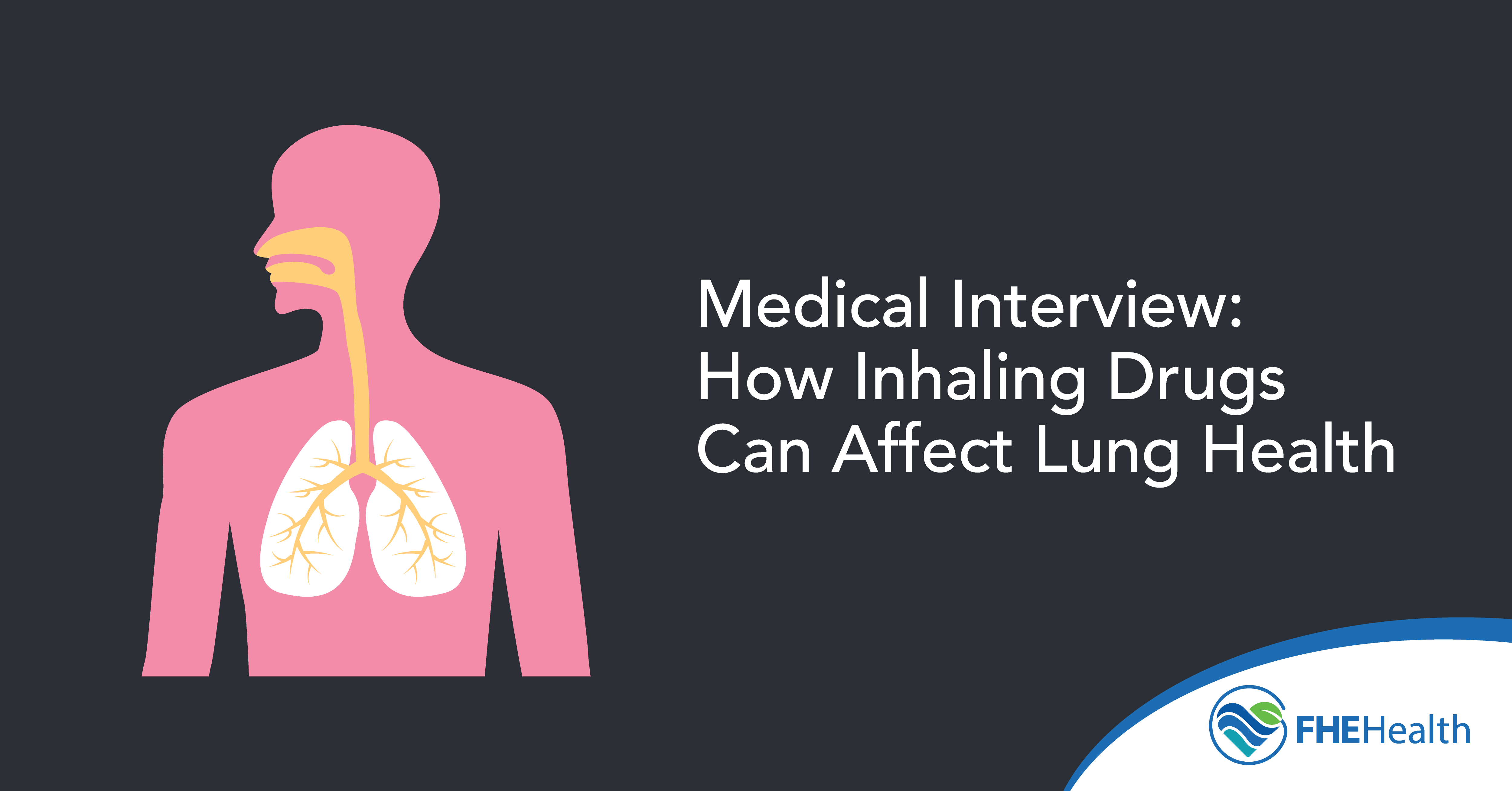
Inhaling or smoking drugs is a popular form of substance use. People commonly smoke not just tobacco, nicotine, and cannabis, but cocaine, methamphetamine, prescription drugs, and nitrous oxide. Even opiates like heroin and fentanyl are used in this way; in fact, some research has pointed to an increasing trend. But smoking any drug poses dangers for lung health.
For help understanding the various ways in which drug inhalation and commonly inhaled drugs can affect the lungs, we reached out to a member of our medical team, Michelle Beck. As a Psychiatric Mental Health Nurse Practitioner, Beck is board-certified in both primary and psychiatric care. Prior to joining FHE Health, she worked extensively with geriatric patients. Beck therefore was able to draw on a wealth of firsthand experience to answer some commonly asked questions. You can catch those insights in the below Q&A….
Drug Inhalation and How the Lungs Work
Q: Why does drug inhalation cause coughing and shortness of breath?
A: When you inhale hot, toxic smoke, your lungs react by producing excess mucus to trap and expel harmful chemicals. This leads to chronic coughing, wheezing, and difficulty breathing. Over time, the lung’s air sacs become damaged and inflamed, making it even harder to breathe.
Short-Term Effects on Lung Health
Irritation and Inflammation
Q: What happens to your lungs when you inhale drugs (and specific drugs like tobacco, nicotine products, crack cocaine, meth, etc.)?
A: Lungs are delicate organs designed to take in oxygen — not burning chemicals, toxic particles, or corrosive substances. When you inhale drugs, your lung tissue becomes inflamed, airways become irritated, and lung function declines.
Acute Risks
Q: Are there immediate risks from inhaling drugs that can be serious or life-threatening?
A: Yes. Some drugs, like crack cocaine and meth, can even cause immediate lung bleeding and collapse due to the harsh chemicals constricting blood vessels and depriving the lungs of oxygen.
Long-Term Effects on Lung Health
Chronic Respiratory Issues and Structural Damage
Q: What can happen to the lungs after long-term drug inhalation?
A: Over time, this leads to permanent scarring, chronic lung disease such as Chronic Obstructive Pulmonary Disease (COPD), and respiratory failure.
Increased Risk of Lung Infections
Q: Can inhaling drugs increase the risk of lung infections?
A: Absolutely. Smoking or inhaling drugs weakens the immune system, destroying the lung’s natural defenses. This makes users highly susceptible to pneumonia, tuberculosis, and fungal infections — some of which can be deadly.
Risks of Lung Cancer
Q: Does inhaling drugs lead to a higher risk of lung cancer?
A: Yes. Any form of inhaling drugs significantly increases the risk of lung cancer. Tobacco is the biggest culprit, but cannabis, crack, and meth also contain carcinogens that damage lung cells, making cancer much more likely.
The Varied Impact of Commonly Inhaled Drugs on the Lungs
Tobacco
Q: How does smoking tobacco differ from inhaling other drugs in terms of lung impact?
A: Tobacco causes gradual damage over decades, leading to lung cancer, emphysema, and COPD. However, drugs like crack, meth, and heroin can destroy lung tissue much faster, sometimes causing life-threatening lung failure in just months or years instead of decades.
Cannabis (Marijuana)
Q: How does smoking cannabis affect lung health?
A: Many people believe cannabis smoke is safer than tobacco, but the reality is, it’s just as harmful — if not worse. Cannabis smoke contains many of the same carcinogens as cigarettes and burns at a higher temperature, which scars the lungs and leads to chronic bronchitis. Heavy cannabis smokers often develop “bong lung,” a condition where their lungs are so damaged that they can barely breathe without coughing up mucus.
Mixing Tobacco with Cannabis
Q: What are the risks of mixing tobacco with cannabis on lung health?
A: “Mixing the two means double the damage. The combination increases airway inflammation, worsens chronic bronchitis, and raises the risk of lung cancer significantly. The two substances also interact in a way that makes tar and toxins linger longer in the lungs, causing faster and more severe lung deterioration.
Crack Cocaine
Q: What are the immediate effects of inhaling crack on the lungs?
A: Inhaling crack delivers a sudden, intense high, but it literally burns the lung tissue in the process. Users can experience severe chest pain, intense coughing fits, wheezing, and even lung collapse. “Crack lung” is a condition where fluid builds up in the lungs, leading to severe respiratory distress and suffocation — even after just a few uses.
Methamphetamine
Q: How does inhaling methamphetamine affect the respiratory system?
A: Meth smoke is highly toxic and causes chemical burns inside the lungs. Long-term meth use can lead to “meth lung,” where lung tissue becomes so inflamed and scarred that it mimics severe pneumonia. This can cause chronic breathing problems, fluid buildup, and respiratory failure.
Vaping
Q: Is vaping less harmful to the lungs than smoking?
A: No! Vaping is not a safe alternative to smoking. E-cigarettes contain toxic chemicals, metals, and carcinogens, which damage the lungs and can cause EVALI (e-cigarette or vaping-associated lung injury), a potentially fatal condition. Vaping can cause irreversible lung scarring, chronic cough, and increased risk of lung infections.
Nitrous Oxide
Q: Are there long-term lung consequences from inhaling nitrous oxide?
A: Yes! Inhaling nitrous oxide reduces oxygen supply to the lungs, leading to permanent lung and brain damage. Over time, it can cause chronic shortness of breath, nerve damage, and even lung collapse due to lack of oxygen.
Preventative Measures and Rehabilitation
Quitting and Recovery
Q: Can lung damage from inhaling drugs be reversed?
A: Some damage can heal after quitting, but much of it is permanent. Once lung tissue is scarred, it never fully recovers. Conditions like COPD, emphysema, and pulmonary fibrosis are irreversible. However, quitting early can prevent further decline, and medications or oxygen therapy can help manage symptoms.
Treatments and Therapies for Lung Rehabilitation
Q: What treatments are available for lung damage caused by drug inhalation?
A: Unfortunately, there is no cure for permanent lung damage. Treatments focus on managing symptoms and may include inhalers, oxygen therapy, steroids, and in severe cases, lung transplants. However, by the time a person needs these treatments, the damage is already done.
Q: How can someone protect their lungs after quitting drug inhalation?
A: The best way to heal your lungs is to quit inhaling drugs immediately. Lung function may improve, but scarring is permanent; and some damage may be irreversible as well. Steps to protect your lungs include avoiding secondhand smoke, exercising to improve lung capacity, staying hydrated, and seeing a doctor for lung function tests.
Q: What are some signs that you may have lung damage from inhaling drugs?
A: “If you’re inhaling drugs and experiencing chronic cough, wheezing, shortness of breath, frequent lung infections, coughing up blood, or chest pain, your lungs are already in trouble. These symptoms often indicate serious, irreversible damage like emphysema, chronic bronchitis, or lung collapse.”
Conclusion
Drug inhalation often provides a faster, more intense high than snorting, ingestion, or injection. Passage through the respiratory system enables rapid absorption in the brain and bloodstream, so that the drug’s euphoric effects set in almost immediately. Yet, what’s also soberingly evident from our interview with Beck is that inhaling drugs can be devastating for a person’s lung health — and that they’ll breathe easier, the sooner they can quit.
If you need a little extra support on the path to better mental and physical health, our medical and clinical professionals are here to help, 24/7. Reach out anytime.






